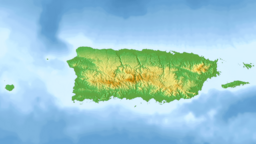Mona Passage
| Mona Passage | |
|---|---|
| Canal de la Mona | |
 Location of the Mona Passage. | |
| Coordinates | 18°30′N 67°53′W / 18.500°N 67.883°W |
| Basin countries | Puerto Rico Dominican Republic |
The Mona Passage (Spanish: Canal de la Mona) is a strait that separates the islands of Hispaniola and Puerto Rico. The Mona Passage connects the Atlantic Ocean to the Caribbean Sea and is an important shipping route between the Atlantic and the Panama Canal.
The Mona Passage is 80 miles (130 kilometers) long. It is fraught with variable tidal currents created by large islands on either side of it, and by sand banks that extend out from both coasts.
Islands
There are three small islands in the Mona Passage:
- Mona Islandlies close to the middle of the Mona Passage.
- Three miles (Five kilometers) northwest of Mona Island is the much smaller Monito Island.
- Thirty miles (Fifty kilometers) northeast of Mona Island and much closer (13 mi/21 km) to the Puerto Rican mainland is Desecheo Island.
Structure and seismicity
The Passage was the site of
Physical oceanography
The Mona Passage connects the Atlantic Ocean waters and Caribbean Sea waters, above a sill depth of 1,312 to 1,640 feet (400 to 500 meters). The sill runs along a northwest to the southeast direction between Cabo Engaño (DR) in the west and the Cabo Rojo Shelf (PR) in the east margin of the Mona Passage. The vertical profile of the low-frequency (periods longer than 2 days) mean meridional water transport is characterized by a two-layer structure. The upper layer lies above a depth of 984 feet (300 meters), with the upper water masses, the Caribbean Surface Water, Subtropical Underwater and Sargasso Sea Water entering the Caribbean Sea from the Atlantic Ocean. Below this layer, the Tropical Central Water exits toward the Atlantic Ocean. The mean value for the meridional (North-South) transport for a sampled year was -1.85 ± 0.25 sverdrup (Sv) into the Caribbean Sea.[3]
The barotropic tide (surface tide) propagates from northeast to southwest along Mona Passage. The "principal lunar semi-diurnal" constituent, also known as the M2 (or M2) accounts for 52.35% of the total variance observed in the ocean currents and the semidiurnal current ellipses, with a clockwise rotation, are roughly aligned in a north–south direction.[4]
Semidiurnal tidal currents impinging on a submarine ridge known as El Pichincho can force the generation of an internal tide with a wave height of 131 feet (40 meters).[5] Underwater glider observations reveal wave damping as the internal tide propagates south along the Mona Passage towards the open Caribbean Sea.[6][7][8]
Internal tides at El Pichincho can elevate the turbulent vertical diffusivity values (or
Higher values of
Images from the
The packets propagate either into the Caribbean Sea or the Atlantic Ocean depending on the direction of the currents that forced their generation.[12]
Surface tides, internal tides, internal solitons, inertial currents and the low frequency water mass transport between the Atlantic Ocean and the Caribbean Sea make the Mona Passage a very dynamic environment.
See also
- Battle of the Mona Passage
- Bays of the Mona Passage
- Mona Canyon
- Old Bahama Channel
References
- ^ a b http://soundwaves.usgs.gov/2007/05/ Archived 2017-04-05 at the Wayback Machine Uri ten Brink, New Bathymetric Map of Mona Passage, Northeastern Caribbean, Aids in Earthquake- and Tsunami-Hazard Mitigation, USGS Sound Waves Newsletter, May 2007
- ISBN 978-0-8137-2385-3
- ^ Segura-Torres, W. (2000). Low frequency transport components in Mona Passage. Ph. D. Dissertation. Department of Marine Sciences, University of Puerto Rico, Mayagüez, Puerto Rico. p. 317.
- ^ Rosario-Llantín, J. (2000). Tidal Currents in Mona Passage. M.S. Thesis. Department of Marine Sciences, University of Puerto Rico, Mayagüez, Puerto Rico. p. 82.
- ^ Bejarano, L. F. (1997). Characterization of the internal tide north of Mona Passage. M.S. Thesis. Department of Marine Sciences, University of Puerto Rico, Mayagüez, Puerto Rico. p. 112.
- ^ Corredor, J. E. (2008). "Development and Propagation of Internal Tides in the Mona Passage" (PDF). Sea Technology. October: 48–50. Retrieved 2014-08-30.
- Bibcode:2008AGUSMOS33B..01C.)
{{cite journal}}: CS1 maint: multiple names: authors list (link - doi:10.4031/MTSJ.44.6.20. Retrieved 2014-09-06.)
{{cite journal}}: CS1 maint: multiple names: authors list (link - PDF). Ph. D. Dissertation. Department of Marine Sciences, University of Puerto Rico, Mayagüez, Puerto Rico. UMI publication AAT 3042382. p. 407. Retrieved 2014-08-25.
- ^ Alfonso-Sosa, Edwin (2015-03-10). "Internal Solitary Waves Generated at Banco Engaño, Mona Passage" ()
- ^ Alfonso-Sosa, E. (2013). "Misterioso Fenómeno en el Pasaje de la Mona" (PDF). La Regata. 7: 10. Retrieved 2014-08-31.
- )
External links
- Ecology and Geology of the Mona Passage Region (in English)
- Ocean Physics Education, Inc. (in English)
- Olas Internas en el Canal de la Mona (in Spanish)

